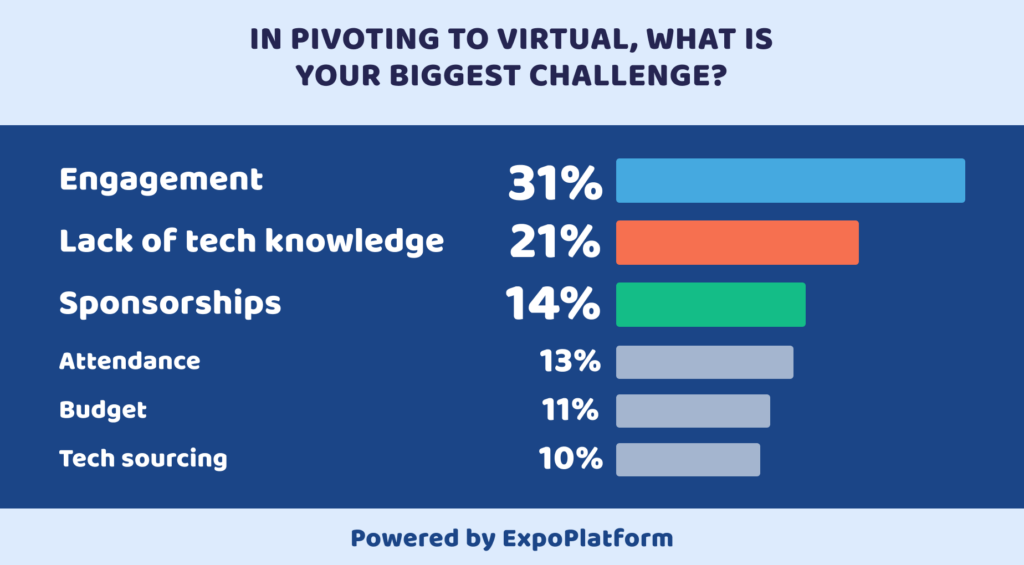
4 Ways to Improve Attendee Engagement at Virtual Exhibitions
The mainstream acceptance of virtual events has introduced a new chapter in audience engagement. Attendees are now able to attend virtual exhibitions and fairs on different continents from their devices, without even having to step out of their seats.
However, this phenomenon has also limited the audience’s interaction to a screen, depriving them of the engagement associated with an in-person exhibition and trade shows. Complete reliance on the digital medium has made it difficult to keep attendees engaged and active.
 Source: EventMB Research
Source: EventMB Research
For a smaller close-knit event, this problem might not hurt a lot. However, for online events with huge attendee numbers e.g. large-scale B2B exhibitions, how do you keep your audience engaged?
Here are some useful tips for improving engagement at virtual exhibitions:
1. Initiate attendees & build communities before the show
Even before the virtual doors of your exhibition open, you can set up online communities to give attendees a teaser of what to expect during the same, allow them to share pre-event experiences and build anticipation.
a) Direct attendees to online groups/forums where various topics are covered under your event. Identify brand champions from these groups who can advocate for your event. For their contribution, these brand champions can be offered some incentives e.g. a free stand, curated meetings, early access to product demos etc.
b) Use referral marketing to entice people who fit naturally within the trade show, but sit outside your contact list. Your little black book may need a revamp, given the events of 2020.

2. Work on the structure of your virtual exhibition
Organising virtual exhibitions means the entire attendee experience takes place on the screen of a digital device. It’s important to ensure the event experience is structured in a way that maximises engagement.
a) Re-structure your event into shorter bite-sized sessions with snackable content presentations to combat screen fatigue and disseminate relevant information. There is greater scope for serialising a presentation into natural sub-topics at a virtual event.
b) Invest in the production value of your content, especially for key notes and sessions with industry leaders. Production quality can be the key difference between high and low engagement rates.
c) Preserve the elements of a live event to ensure your online show is not completely divorced from the traditional event model. Live events happen within a certain time period and if you extend the timeframe indefinitely, audience participation can decline significantly.

3. Provide personalised options to cut through the noise
Personalisation can help both attendees and exhibitors engage more effectively in a virtual environment. Based on the preferences filled by participants during registration, you can create a custom event journey for attendees.
a) Use AI-powered matchmaking to provide attendees (as well as exhibitors) with customised recommendations to connect with people, products, and content most relevant to them. These connections are based on preferences filled out before logging into the event and can be changed if the user doesn’t find a suitable match.
b) Employ multilingual chatbots to create quick, real-time personalised experiences. Apart from onboarding and troubleshooting, chatbots can be used effectively on product and exhibitor profiles associated with a transactional value, as well as a personal guide.

4. Improve two-way communication
Two-way communication is key for effective engagement. You can create more opportunities for information sharing in the following ways.
a) Use virtual breakout rooms to set up and nurture small focus groups, which can be created on the basis of different session topics. Representatives from each group can be selected to moderate the discussions and provide suggestions from the audience to the speaker(s).
b) Provide facilities for interactive Q&A sessions, surveys, polls and live group chats to ensure active attendee participation during the exhibition.
c) After the session, representatives from various community groups and forums can raise questions to speakers and voice recommendations, suggestions, or the general viewpoint of their group.

Conclusion
Apart from these, focus on introducing elements of entertainment such as contests and quizzes, and wellbeing such as virtual happy hours. These can help attendees to unwind effectively from the exhaustion.
Attendee engagement is one of the most crucial metrics to determine your show’s success. The more people stay engaged, the more insights you get to build an attendee persona, generate better-qualified leads and drive ROI.
There's more you might like

New partnership cemented for UK Construction Week
A new events partnership will see a major stone industry show being held along with UK Construction Week. The Stone Show & Hard Surfaces will co-locate with UK Construction Week in May. The Concrete Show will also unite with the UK Concrete Show, further consolidating the industry offerings. Read more about it below. Here are ...

Events have ‘huge power’ to cut CO2, but minds must change
Eventprofs have a “huge amount of power” to make our industry more sustainable – but mindsets must change, according to an industry expert. Anna Abdelnoor, CEO of isla, told how the vast majority of impactful decisions can be made in the planning stage, rather than trying to work out how to reduce waste after a ...

92% plan to improve post-event follow-ups – Forrester
More than 90% of event professionals plan to improve their attendee follow-up strategies to maximize ROI, according to a new study. The Forrester study also highlights eight key trends eventprofs should focus on this year. Get the complete details below. Here are the top headlines for your weekly event news updates: 92% aim to prioritize ...

